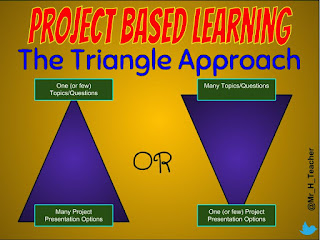As I mentioned in my first post, the approach to a PBL needs to take on a Triangular Shape.
Either...
- Many choices (questions) with a single (or few) final product choices.
- One (or few) choices with multiple options for presentation.
At the time of this writing, I am working with a Grade 3/4 teacher to develop a PBL approach to the Light & Sound section in the Grade 4 Ontario Science Curriculum. We have decided to use triangle two (on the right). Multiple curriculum prompts with learning demonstrated through either a Tri-Fold Brochure or Infographic (possibly with a QR code to a Google Site.)
Step 1: Start with the Curriculum
Go through the curriculum and pull out the specific expectations and example questions you want the students to explore. I have organized them into this table.
Step 2: Decide on the Culminating Task
- Explore a Multi-Media Tech Set to learn about the elements of Light and Sound that are identified in the curriculum.
- Identify a question they would like to answer or an area they would like to explore.
- At this age, we need to help support them finding "open" questions or provide meaningful question prompts.
- Research their question and organize the information into either an Infographic or a Brochure
- Both of these products will need to be "front-loaded" through literacy activities.
- Optionally, students could include a QR code to a Google Site that contains the same information.
Step 3 - Solidify Evaluation Approach
- Feedback throughout the project is essential - especially for young children and those participating in a PBL for the first time.
- Learning Skills need to be addressed regularly - student self-evaluation through Google Forms might be a good strategy. I have also provided time at the end of each work period for students to document their progress and share it with their parents (I used Student Story in Class Dojo)
- The Final Project should be assessed using a No Mark Rubric co-created with students so that they fully understand the expectations. Perhaps...
- Aesthetic Appearance - Communication of Understanding & Media
- Organization of Information - Literacy, Research, Reading and Writing
- Literacy Conventions - Editing & Using Google Tools
- Overall Understanding - Can the student explain their understanding & knowledge?
Next - Building the Multi Media Tech Set

No comments:
Post a Comment